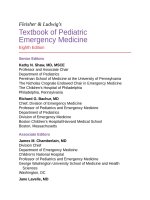Pediatric emergency medicine trisk 1472 1472
Bạn đang xem bản rút gọn của tài liệu. Xem và tải ngay bản đầy đủ của tài liệu tại đây (129.72 KB, 1 trang )
pharyngoconjunctival fever (adenovirus). These viral infections are closely
followed in frequency by bacterial infections caused by group A streptococci
(Streptococcus pyogenes ). During streptococcal outbreaks, as many as 30% to
50% of episodes of pharyngitis may be caused by S. pyogenes in school-aged
children. Another common infectious agent in pharyngitis is the Epstein–Barr
virus, which causes infectious mononucleosis. Although infectious
mononucleosis is not often seen in children younger than 5 years ( Fig. 74.1 ), it
commonly affects the adolescent. One additional important consideration in
adolescents with an infectious mononucleosis-like syndrome is acute human
immunodeficiency virus (HIV) infection, which does not commonly cause
significant pharyngeal inflammation.
Other organisms produce pharyngitis only rarely; these include Neisseria
gonorrhoeae,
Corynebacterium
diphtheriae,
Francisella
tularensis,
Fusobacterium necrophorum, and other bacteria. N. gonorrhoeae may cause
inflammation and exudate but more often remains quiescent, being diagnosed
only by culture. Diphtheria is a life-threatening but seldom encountered cause of
infectious pharyngitis, characterized by a thick membrane and marked cervical
adenopathy. Oropharyngeal tularemia is rare and should be entertained only in
endemic areas among children who have an exudative pharyngitis that cannot be
categorized by standard diagnostic testing and/or persists despite antibiotic
therapy. Although unusual, mixed anaerobic infections should be considered in
the ill-appearing adolescent with a severe pharyngitis because these organisms
occasionally lead to complications such as infected thrombophlebitis and sepsis
(Lemierre syndrome). Arcanobacterium haemolyticum has been isolated from
0.5% to 2.0% of adolescents with pharyngitis, often in association with a
maculopapular rash. Other pathogens—group C and G streptococci, Mycoplasma
pneumoniae, and Chlamydia pneumoniae —have been implicated as agents of
pharyngitis in adults, but in childhood, their roles remain unproven and their
frequency is unknown.
Irritative Pharyngitis/Foreign Body
Drying of the pharynx may irritate the mucosa, leading to a complaint of sore
throat. This condition occurs most commonly during the winter months,
particularly after sleeping in a house with forced hot-air heating. Occasionally, a
foreign object such as a fishbone or popcorn shell may become embedded in the
pharynx resulting in pain.
Herpetic Stomatitis









